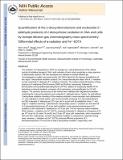Quantification of the 2-Deoxyribonolactone and Nucleoside 5 '-Aldehyde Products of 2-Deoxyribose Oxidation in DNA and Cells by Isotope-Dilution Gas Chromatography Mass Spectrometry: Differential Effects of gamma-Radiation and Fe[superscript 2+]-EDTA
Author(s)
Chan, Wan Simon; Chen, Bingzi; Wang, Lianrong; Taghizadeh, Koli; Demott, Michael S.; Dedon, Peter C.; ... Show more Show less
DownloadDedon-2010-ACS-Quantification.pdf (1.042Mb)
OPEN_ACCESS_POLICY
Open Access Policy
Creative Commons Attribution-Noncommercial-Share Alike
Alternative title
Quantification of the 2-Deoxyribonolactone and Nucleoside 5 '-Aldehyde Products of 2-Deoxyribose Oxidation in DNA and Cells by Isotope-Dilution Gas Chromatography Mass Spectrometry: Differential Effects of gamma-Radiation and Fe2+-EDTA
Terms of use
Metadata
Show full item recordAbstract
The oxidation of 2-deoxyribose in DNA has emerged as a critical determinant of the cellular toxicity of oxidative damage to DNA, with oxidation of each carbon producing a unique spectrum of electrophilic products. We have developed and validated an isotope-dilution gas chromatography-coupled mass spectrometry (GC−MS) method for the rigorous quantification of two major 2-deoxyribose oxidation products: the 2-deoxyribonolactone abasic site of 1′-oxidation and the nucleoside 5′-aldehyde of 5′-oxidation chemistry. The method entails elimination of these products as 5-methylene-2(5H)-furanone (5MF) and furfural, respectively, followed by derivatization with pentafluorophenylhydrazine (PFPH), addition of isotopically labeled PFPH derivatives as internal standards, extraction of the derivatives, and quantification by GC−MS analysis. The precision and accuracy of the method were validated with oligodeoxynucleotides containing the 2-deoxyribonolactone and nucleoside 5′-aldehyde lesions. Further, the well-defined 2-deoxyribose oxidation chemistry of the enediyne antibiotics, neocarzinostatin and calicheamicin γ1I, was exploited in control studies, with neocarzinostatin producing 10 2-deoxyribonolactone and 300 nucleoside 5′-aldehyde per 106 nt per μM in accord with its established minor 1′- and major 5′-oxidation chemistry. Calicheamicin unexpectedly caused 1′-oxidation at a low level of 10 2-deoxyribonolactone per 106 nt per μM in addition to the expected predominance of 5′-oxidation at 560 nucleoside 5′-aldehyde per 106 nt per μM. The two hydroxyl radical-mediated DNA oxidants, γ-radiation and Fe2+−EDTA, produced nucleoside 5′-aldehyde at a frequency of 57 per 106 nt per Gy (G-value 74 nmol/J) and 3.5 per 106 nt per μM, respectively, which amounted to 40% and 35%, respectively, of total 2-deoxyribose oxidation as measured by a plasmid nicking assay. However, γ-radiation and Fe2+−EDTA produced different proportions of 2-deoxyribonolactone at 7% and 24% of total 2-deoxyribose oxidation, respectively, with frequencies of 10 lesions per 106 nt per Gy (G-value, 13 nmol/J) and 2.4 lesions per 106 nt per μM. Studies in TK6 human lymphoblastoid cells, in which the analytical data were corrected for losses sustained during DNA isolation, revealed background levels of 2-deoxyribonolactone and nucleoside 5′-aldehyde of 9.7 and 73 lesions per 106 nt, respectively. γ-Irradiation of the cells caused increases of 0.045 and 0.22 lesions per 106 nt per Gy, respectively, which represents a 250-fold quenching effect of the cellular environment similar to that observed in previous studies. The proportions of the various 2-deoxyribose oxidation products generated by γ-radiation are similar for purified DNA and cells. These results are consistent with solvent exposure as a major determinant of hydroxyl radical reactivity with 2-deoxyribose in DNA, but the large differences between γ-radiation and Fe2+−EDTA suggest that factors other than hydroxyl radical reactivity govern DNA oxidation chemistry.
Date issued
2010-04Department
Massachusetts Institute of Technology. Department of Biological Engineering; Massachusetts Institute of Technology. Department of Civil and Environmental EngineeringJournal
Journal of the American Chemical Society
Publisher
American Chemical Society
Citation
Chan, Wan et al. “Quantification of the 2-Deoxyribonolactone and Nucleoside 5′-Aldehyde Products of 2-Deoxyribose Oxidation in DNA and Cells by Isotope-Dilution Gas Chromatography Mass Spectrometry: Differential Effects of gamma-Radiation and Fe[superscript 2+]-EDTA.” Journal of the American Chemical Society 132 (2010): 6145-6153
Version: Author's final manuscript
ISSN
0002-7863
1520-5126